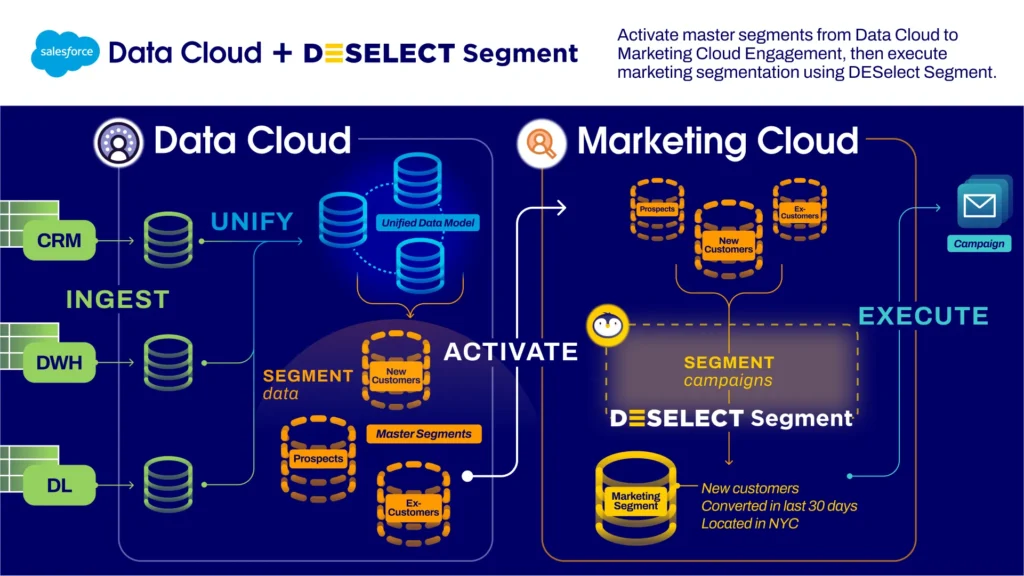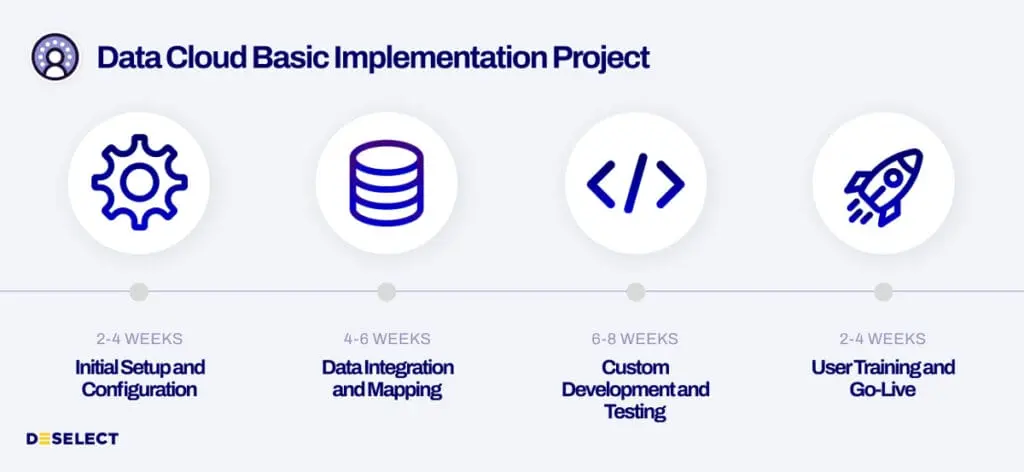Salesforce Data Cloud Implementation: A Comprehensive Guide
Introduction to Salesforce Data Cloud
In recent years, Salesforce has made a strong push into the Customer Data Platform (CDP) space with the introduction of Salesforce Data Cloud. Salesforce Data Cloud operates within the broader Salesforce Platform, which provides integrated data management and analytics capabilities. Data Cloud enables businesses to manage and leverage their customer data across multiple touchpoints, enabling marketers to leverage their data better than ever.
It is important to note that different stakeholders may refer to Salesforce Data Cloud by various names, such as CDP or Customer 360 Audiences, but the current terminology is Salesforce Data Cloud for consistency. By bringing together data from various sources, Data Cloud helps create a unified 360 view of each customer, facilitating more personalized and effective marketing campaigns.
From Customer 360 Audiences to Data Cloud
Salesforce Data Cloud, formerly known as Customer 360 Audiences, Salesforce CDP, and Genie, has undergone significant transformations since its inception. Initially launched as Customer 360 Audiences, the platform aimed to help businesses unify customer data across multiple touchpoints. Over time, it evolved into Salesforce CDP and later Genie, each iteration bringing new features and improvements. Today, it represents a robust solution for businesses looking to harness the power of their customer data.

Understanding Customer Data Platforms (CDPs)
Customer Data Platforms (CDPs) like Salesforce Data Cloud are crucial for modern digital marketing. A CDP gathers and unifies customer data from various touchpoints—websites, CRM systems, social media—into a single, cohesive profile. This unified view allows for highly personalized marketing strategies, making your campaigns more effective and targeted.
While Salesforce Data Cloud is a leading CDP, several other platforms also offer robust data management solutions. Adobe Experience Platform is a comprehensive CDP that integrates data from various sources to provide real-time customer profiles and insights. Segment, acquired by Twilio, is known for its ease of use and powerful integrations, enabling businesses to collect, unify, and route customer data. Another notable CDP is Microsoft Customer Insights, which leverages AI to unify data and provide actionable insights across sales, marketing, and service departments. What makes Salesforce Data Cloud stand out, of course, is its robust capabilities combined with both native integrations with other Salesforce products as well as hundreds of connectors for non-Salesforce products, including the capability for zero-copy data. Organizations leverage Data Cloud to unify customer data, enhance operational agility, and improve customer experiences by creating a comprehensive, centralized view of customer information across multiple channels and touchpoints. Additionally, Salesforce Data Cloud offers comprehensive data cloud features such as data ingestion, modeling, data viewing, identity resolution, calculated insights, and administrative configuration, making it a powerful and flexible platform for managing customer data.
Overview of Salesforce Data Cloud
Salesforce Data Cloud stands out as a comprehensive platform that enables businesses to manage their customer data effectively. It’s geared around four key capabilities:
- Ingestion
- Unification
- Segmentation
- Activation
A successful data cloud setup requires careful planning of the data model and a clear understanding of business processes to ensure the platform meets organizational needs.

The four key functions of Salesforce Data Cloud
By integrating with both Salesforce’s suite of products and 3rd party solutions, Data Cloud provides a seamless experience for businesses looking to enhance their marketing efforts and drive better customer engagement.Ingestion: Seamlessly Gather Data
A cornerstone of Salesforce Data Cloud is its ability to ingest data from multiple sources. Whether it’s data from social media, CRM systems, or other marketing tools, Data Cloud ensures that all information is captured accurately and efficiently. This capability allows businesses to have a holistic view of their customer interactions, which is crucial for developing targeted marketing strategies.
For example, many customers choose to integrate their Data Warehouse (DHW) or Data Lake (DL) into Data Cloud. This is now also made possible through the zero-copy data capability.Unification: Creating a Single Customer View
Once the data is ingested, Salesforce Data Cloud excels in unifying this information to create a single customer view. This process involves merging data from various sources to eliminate duplicates and inconsistencies. Salesforce Data Cloud can unify data at both the individual and account level, enabling account-specific data management and configuration. The result is a comprehensive and accurate profile of each customer, which can be used to tailor marketing efforts more effectively.
For example, if a customer updates their address on your website, Salesforce Data Cloud ensures this change reflects across all systems, eliminating duplicates and outdated information. This unified profile helps in creating personalized marketing strategies that truly resonate with the customer.Segmentation: Targeting the Right Audience
Effective marketing hinges on the ability to segment your audience accurately. Salesforce Data Cloud offers powerful segmentation tools that allow businesses to categorize their customers based on various criteria such as behavior, preferences, and demographics. Calculated insights within Salesforce Data Cloud provide predefined metrics that help create more effective segments and support data-driven marketing strategies. By leveraging these segments, businesses can craft highly personalized and relevant marketing campaigns.
Example: You could create a segment of recent new customers so you can use this for welcome journeys. If you are looking to segment for the sake of executing campaigns from Marketing Cloud Engagement, Data Cloud offers one robust way to do this, although there are multiple ways to segment in Marketing Cloud.Activation: Making Data Actionable
The final step in the data journey is activation. Salesforce Data Cloud empowers businesses to make their data actionable by integrating it with other marketing tools and platforms. This integration ensures that customer data can be used in real-time to drive engagement and conversions. Whether it’s through email marketing, social media campaigns, or other channels, Data Cloud helps businesses connect with their customers in meaningful ways.
Example: You want to push your segment of recent new customers to an ads channel for retargeting purposes. Do note that Activations in Salesforce Data Cloud are priced based on usage. Understanding credit consumption is crucial, as data ingestion, activation, and profile unification all impact the overall credits used within Data Cloud. In addition, depending on the scope of your customer data in Data Cloud, Data Cloud may be daunting for non-technical users. For this reason, you may want to consider building ‘master segments’ in Data Cloud, and pushing these through to, for example, Marketing Cloud Engagement, where you perform and execute more granular segmentation.Data Cloud Integration Capabilities
Data Cloud offers integration capabilities with both Salesforce product and non-Salesforce products. This integration happens through the configuration of so-called ‘Data Streams.’
Proper configuration of permissions is essential to ensure secure and effective integration of Data Cloud with other platforms.Integrating Salesforce Data Cloud with Other Salesforce Products
Salesforce Data Cloud seamlessly integrates with a wide array of Salesforce products, enhancing the functionality and connectivity within the Salesforce ecosystem. Here are some key integrations:
- Salesforce Marketing Cloud: Use Data Cloud to feed unified customer profiles into Marketing Cloud for highly personalized and targeted campaigns. This is one of the most common integrations and use cases for Data Cloud.
- Salesforce Sales Cloud: Provide sales teams with a 360-degree view of customers, enabling more informed and effective sales strategies.
- Salesforce Service Cloud: Equip customer service teams with comprehensive customer profiles to improve service quality and personalize interactions.
- Salesforce Commerce Cloud: Leverage customer data to create personalized shopping experiences, boosting customer engagement and sales.
Integrating Salesforce Data Cloud with Non-Salesforce Products
Salesforce Data Cloud also integrates with numerous non-Salesforce products, making it a versatile tool for managing and leveraging customer data. Some of the most common integrations include:
- Snowflake: Zero-copy data sharing capabilities allow data to be accessed in Snowflake without physically moving it, maintaining data integrity and reducing latency.
- Google Cloud: Integrate with Google Cloud for seamless data exchange and enhanced analytics capabilities.
- Amazon S3: Use Data Cloud to unify data stored in Amazon S3, ensuring a comprehensive view of customer interactions.
- Microsoft Azure: Leverage Azure’s powerful data processing and storage capabilities by integrating with Salesforce Data Cloud.
- Databricks: Enable advanced analytics and machine learning by connecting Databricks with Salesforce Data Cloud.
Zero-Copy Data Capabilities
Salesforce recently announced zero-copy data capabilities, which revolutionize how data is managed and accessed. With zero-copy architecture, data can be integrated and viewed within Salesforce Data Cloud without being physically moved or duplicated. This ensures data integrity, reduces storage costs, and improves performance. By leveraging partnerships with platforms like Snowflake and Google Cloud, Salesforce enables businesses to access real-time data insights seamlessly.
Integrating Salesforce Data Cloud with DESelect
Although not a direct integration, DESelect allows users to extend Data Cloud’s capabilities. Here’s how:
- Send Frequency Optimization: DESelect Engage optimizes send frequency, ensuring that marketing messages reach the audience at the right time and frequency. By leveraging the unified customer data from Salesforce Data Cloud, DESelect Engage enhances campaign effectiveness and prevents over-saturation.
- Master Segment Creation: Salesforce Data Cloud helps in creating master segments by unifying and organizing customer data. These segments can be pushed to DESelect Segment for further refinement and precise audience targeting within Salesforce Marketing Cloud Engagement.

Complete sophisticated segmentation with DESelect
Competitive Advantages and Potential Drawbacks
Advantages of Salesforce Data Cloud
Salesforce Data Cloud offers numerous advantages that make it a valuable tool for businesses. These include its ability to integrate multiple data sources, unify data to create a single customer view, and provide powerful segmentation and activation capabilities. Additionally, its seamless integration with other Salesforce products ensures that businesses can leverage the full power of the Salesforce ecosystem to enhance their marketing efforts.
Potential Drawbacks and Limitations
While Salesforce Data Cloud offers many benefits, it is not without its potential drawbacks and limitations. One of the primary concerns for businesses is the cost, as Data Cloud is known to be relatively pricey compared to other CDP solutions. Additionally, some users may find the platform’s complexity to be a barrier to entry, particularly for smaller businesses with limited resources. However, these challenges can often be mitigated through careful planning and the use of complementary tools such as DESelect Segment and Engage.
Product Pricing
Salesforce Data Cloud is positioned as a premium solution, reflecting its advanced capabilities and integration potential within the Salesforce ecosystem. Detailed pricing information can be found on the Salesforce Data Cloud pricing page.
The key takeaway is that while Data Cloud comes at a considerable base cost, what really drives the price are the additional SKUs/add-ons that are required to actually operate it.
Key SKUs and Pricing Drivers
Data Services Credits: Pricing is based on the use of Data Services Credits, which cover data ingestion, transformation, and unification.
Contacts: The number of unique contacts managed in the Data Cloud influences pricing.
Data Storage: Costs are determined by the amount of data stored in the platform.
Advanced Analytics: Utilizing advanced analytics and segmentation tools can impact overall costs.
API Calls: The number of API calls made to integrate and retrieve data also affects pricing.
Usage Examples
Small Business: A small business with moderate data ingestion and storage needs might see lower costs, focusing primarily on essential features.
Enterprise: A large enterprise with high data volumes, extensive processing requirements, and numerous user licenses will likely experience higher pricing, reflecting the scale of their operations.
Implementation Costs and Considerations
Implementing Salesforce Data Cloud involves several stages, each contributing to the overall timeline and complexity of the project. Key implementation steps typically include initial planning, data integration, configuration, testing, user training, and post-launch support. Analyzing past data cloud implementations can help identify best practices and avoid common pitfalls, increasing the likelihood of a successful deployment. Here’s what a typical implementation might look like:

Salesforce Data Cloud implementation takes a minimum of 3 months, likely much longer
Expected Timelines
Initial Setup and Configuration: 2-4 weeks
Data Integration and Mapping: 4-6 weeks
Custom Development and Testing: 6-8 weeks
User Training and Go-Live: 2-4 weeks
This would be for a typical project but do note that the duration goes up proportionally to the amount of implementation work required. It’s not uncommon for Data Cloud to require 6 to 18 months to be fully up and running for a larger enterprise organization.
Common Attention Points
Data Quality and Cleansing: Ensuring data is accurate, consistent, and free from duplicates.
Integration Complexity: Managing integrations with various data sources and platforms.
User Adoption: Providing adequate training and support to ensure users are comfortable with the new system.
Compliance and Security: Adhering to data privacy regulations and ensuring robust security measures.
Implementing Salesforce Data Cloud is a substantial investment, both in terms of time and resources, but the benefits of unified, actionable customer data can significantly enhance marketing efforts and business outcomes.
Additional Data Cloud Resources
Data Cloud Trailhead Modules and Courses:
History of Salesforce Data Cloud:
Data Cloud Implementation Guides:
Conclusion
Salesforce Data Cloud represents a powerful tool for businesses looking to leverage their customer data effectively. With its comprehensive features for data ingestion, unification, segmentation, and activation, it provides a solid foundation for creating personalized and impactful marketing campaigns. By integrating with other Salesforce products and complementary tools like DESelect Segment and Engage, businesses can enhance their marketing efforts and drive better results. Despite its higher cost, the benefits of Salesforce Data Cloud make it a worthwhile investment for businesses committed to maximizing the value of their customer data. You can learn more by watching this webinar on demand today.


